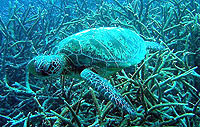
|
||||||||
|
There are only seven species of sea turtle found worldwide and six of them are found in Australian waters. These are the loggerhead, green, hawksbill, olive ridley, flatback and leatherback turtles. Most sea turtles are found in warm, tropical oceanic waters and so are mostly seen in northern Australian waters. However, leatherback turtles have a global distribution and can also be found in colder waters, such as around southern Australia. In most parts of the world, sea turtles are considered to be endangered or critically endangered of going extinct, with the exception of the flatback turtle. The flatback turtle may be in a similar plight yet little is known about the species to be sure. There is a worldwide ban on the trade of sea turtle products. Sea turtles are a culturally important part of the diet in some Australian Indigenous communities but they are otherwise protected. Why are we concerned about turtles? |
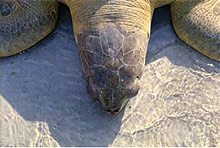 The introduction of turtle excluder devices has greatly reduced the capture of turtles in the Northern Prawn Fishery. (courtesy CSIRO Marine and Atmospheric Research) |
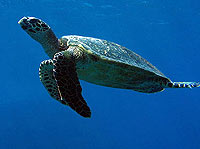 Hawksbill turtle (courtesy of Gareth Phillips via Flickr) |
A sea turtle spends most of its life feeding in ocean waters and travelling across them to breed and nest. Some sea turtles migrate huge distances, usually around 500km and sometimes as far as 2500km, from their feeding areas to their nesting beaches. During their migration, turtles can come into contact with many threats including fishing where they can get accidentally captured or killed as a result. Australia has important nesting beaches for all six Australian species, and for the flatback turtle, Australia is the only place where nesting has been recorded. Most female sea turtles breed every 2-8 years, laying up to 8 separate egg clutches each breeding season. After hatching, the young turtles venture into the ocean and will not return to land for many years. It takes between 30-50 years for a turtle to mature and begin to breed. This means that they are a slow maturing and a slow reproducing species. |
Because they take so many years to mature, interrupting their nesting, loss of eggs, capture and accidental drowning of turtles can have a great effect on the size of the population. Turtle populations will take a long time to recover if their numbers are reduced. Australia has developed a Recovery Plan for marine turtles that addresses the key threats to turtle populations to ensure their populations recover. Many human activities can have a negative effect on sea turtle populations. Coastal development near nesting beaches can deter or prevent female sea turtles from successfully laying their clutches of eggs. Female turtles return to nest in the area where they were born, to either the same beach or a beach in the region. Feral animals can destroy nests and bright lights can confuse hatchlings, preventing them from making it to the ocean. |
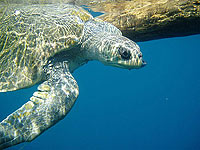 Olive Ridley turtle (courtesy of Courtney Burge via Flickr) |
Turtles are also occasionally caught as bycatch in some commercial fisheries and they are also likely to be caught accidentally by recreational fisheries. Sea turtles are also of great Indigenous cultural significance, particularly in Northern Australia where they play an important role in the traditions and diets of many communities.
How do turtles and fisheries interact?
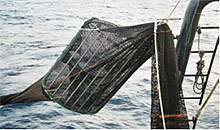 Turtle excluder devices are used in trawl nets to reduce bycatch of turtles. (courtesy of CSIRO Marine and Atmospheric Research) |
While fishers may only occasionally catch turtles as bycatch, this needs to be avoided to assist in the recovery of their populations. To protect turtles it is necessary to reduce all impacts that could possibly effect their populations, including fishing. Fishers don’t want to catch turtles. Interactions between turtles and commercial fisheries sometimes occur during oceanic longline fishing and prawn trawling in tropical waters. A longline consists of a main fishing line with numerous baited hooks attached to branch lines and are used in the open ocean to catch tuna and billfish. Some turtles are attracted to the baits, such as squid, because it is a prey species they naturally eat. The turtles may get hooked just like a fish if they try to eat the bait. |
Other species, such as the leatherback turtle are attracted to the floats, and because of their large size, they get tangled in the fishing line. Leatherbacks are the largest sea turtle species and can grow as big as 1.8 m long and weigh up to 500kg. Prawn trawls are large nets pulled along the seafloor behind a boat, to catch prawns. Turtles live in the same areas as prawns and can get caught and potentially drown in the net.
Australian fisheries have taken significant steps to reduce turtle bycatch.
How are fisheries managing these interactions?
Tropical prawn trawl fisheries Australian fishers, researchers, managers and others have worked together to collection information on turtle bycatch and ways to reduce it since the early 1990s As a result of this Turtle Excluder Devices (TEDs) are compulsory in all Australian tropical prawn trawl fisheries. TEDs reduce the bycatch of turtles by guiding the turtles across a large grid placed in the net and out through an opening in the net. The prawns pass through the grid and still get caught. The use of TEDs has virtually eliminated turtle bycatch in these fisheries. Guides for fishers on how to handle and release turtles have also been developed to increase survival of the few turtles that are captured. In the Northern Prawn Fishery turtle bycatch was reduced from about 5500 during 1999 to less than 50 during 2000, and turtle deaths have been reduced from about 1200 to less than 12 per year. |
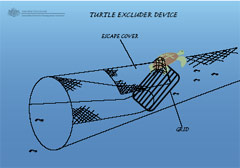 Turtle Excluder Device in a prawn trawl net. (diagram courtesy of AFMA) |
 A longline hook with wire leader, the wire makes it harder for an animal, such as a shark to bite through the line if caught. Wire leaders are banned in some Australian fisheries to reduce the bycatch of sharks. (courtesy BRS) |
Oceanic longline fisheries The type of bait and hook used and how deep the lines are set in longline fisheries will affect the chance of hooking a turtle. Some fishers are using ‘circle hooks’, which are less likely to be eaten by a turtle and if the turtle is hooked do less damage. Australian fisheries managers, researchers and environmental extension officers such as SeaNet (OceanWatch, Australia), are working with fishers to promote the use of line-cutters and de-hookers to encourage safe release of turtles. |
Find out More
Department of the Environment and Water Resources (DEW) - Sea Turtles:
www.deh.gov.au/coasts/species/turtles/index.htmlRecovery plan for marine turtles - DEW:
www.deh.gov.au/coasts/publications/turtle-recoveryBycatch of sea turtles in pelagic longline fisheries – Australia, Bureau of Rural Sciences: affashop.gov.au/product.asp?prodid=12758
Monitoring the catch of turtles in the Northern Prawn Fishery: Department of Agriculture, Fisheries and Forestry (DAFF)
www.daff.gov.au/content/publications.cfm?Category=Fisheries%20and%20
Marine%20Sciences&ObjectID=26A9E754-A7F8-4368-8861A9BA4D5F5663
Green turtle
(courtesy of Matt Hobbs via Flickr)One in a Thousand the miraculous life of the sea turtle, Education kit – Fisheries Research and Development Corporation:
www.frdc.com.au/research/online%5Fresources/turtle.phpOceanwatch Australia – SeaNet Environmental Extension Service:
www.oceanwatch.org.auEnvironment Protection Agency, Queensland Government – Turtles:
www.epa.qld.gov.au/nature_conservation/wildlife/native_animals/
watching_wildlife/turtles/Australian Fisheries Management Authority- Turtle excluder devices (TEDs):
www.afma.gov.au/information/students/methods/ted.htmCSIRO Marine and Atmospheric Research:
www.cmar.csiro.auA hatchling Flatback turtle
(courtesy of badoo_tealeaf
(Mel) via Flickr)
Acknowledgements
This information sheet has been compiled using the expertise and support from a number of sources. One in a Thousand: The miraculous life of the sea turtle produced by Hatchling Productions and Belldi Consultancy; Bycatch of Marine Turtles in Longline fisheries in Australia produced by BRS; Recovery plan for marine turtles produced by DEW; Assessment and improvement of TEDs and BRDs in the NPF, produced by CSIRO Marine and Atmospheric Research.

